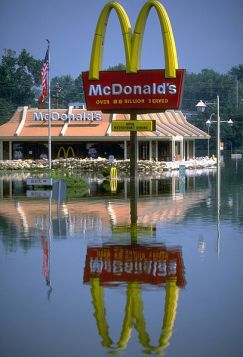By Roberta Attanasio, Blog Editor
For millennia, human societies have altered river flows in different ways. In the 20th century, the impact of human activities on rivers and watershed environments has increased exponentially—and engineering works such as channelization and dam construction have created new, complex, hybrid human-natural systems.

Great Flood of 1993, with the Mississippi River out of its banks in Festus, Missouri. Photo courtesy of the Federal Emergency Management Agency
One of the best examples of these systems is the Mississippi River. As Alexis Madrigal aptly , “The Mississippi no longer fits the definition a river as ‘a natural watercourse flowing towards an ocean, a lake, a sea, or another river.’ Rather, the waterway has been shaped in many ways, big and small, to suit human needs. While it maybe not be tamed, it’s far from wild – and understanding the floods that are expected to crest in Louisiana soon means understanding dams, levees, and control structures as much as rain, climate, and geography.”
, periodic floods have plagued the Mississippi River. In the early 18th century, the French settlers that started to build New Orleans also built levees, marking the beginning of a long and disparate series of infrastructure projects that continue to the present time. Now, results from a new study show a dramatic increase in size and frequency of extreme floods in the past century—mostly (about three-quarters) due to projects to straighten, channelize, and bound the river with artificial levees.
The study () was published in the journal Nature (April 5, 2018). Sam Muñoz, lead author of the study, : “The floods that we’ve had over the last century are bigger than anything we’ve seen in the last 500 years. There’s been a longstanding question about the extent to which all the changes we have made to the Mississippi River—one of the most engineered rivers in the world—have altered the probability of really large floods.”
To answer this longstanding question, Muñoz and his collaborators focused on the lower Mississippi (below the Ohio River confluence) and, more specifically, on three oxbow lakes adjacent to the Mississippi River. Oxbow lakes form when meanders of a river are cut off from the main channel and form free-standing bodies of water. During large floods, river water flows into them again, carrying suspended sediments. When flood waters recede, sediments sink to the oxbow’s bottom, where they settle—providing telltale signs of past floods.

Pictures from Effigy Mounds National Monument, Iowa. Mississippi River with part of an Oxbow lake on the side. Photo by Yinan Chen
The scientists extracted long cores of bottom sediments from the three oxbow lakes, and then used different techniques to characterize the sediments and estimate the size and timing of previous floods. They also studied annual tree rings to reconstruct a detailed record of more recent regional flooding. Thus, they were able to map a history of floods that stretches back to the early sixteenth century.
Next, the scientists compared size and timing of previous floods with records of naturally oscillating climate cycles that affect sea surface temperatures in the Pacific and Atlantic oceans, and found that El Niño events bring more storms and rainfall to central North America. The El Niño storms saturate the ground around the Mississippi, whereas one phase of the Atlantic Ocean oscillation brings extreme rainfall over the Mississippi basin—when the two events overlap, flooding is more likely.
Notably, the scientists found that the natural rhythm of flooding caused by ocean changes was inadvertently and greatly amplified by major federally-funded river engineering projects that began after the great flood of 1927 to facilitate commercial navigation on the river and to protect communities and cropland from floods.
In an accompanying in Nature, Scott St. George points out that “blaming floods on the infrastructure that was built to guard against them will be controversial,” as other climatic factors might also have affected the rhythm of the river. At the same time, he concludes “if the authors are correct, and collective efforts to subdue the Mississippi have inadvertently pushed it to rise higher than ever, then the time might have come to consider loosening its restraints.”
Indeed, as mentioned above, the Mississippi River has been restrained and “channelized” by the U.S. Army Corps of Engineers, as directed by Congress through the Flood Control Act of 1928. The lower Mississippi moved slowly and meandered, with bends up and down it. In order to aid navigation and control the flow of water, the river has been made straighter by cutting channels between parts of it—waters are now mostly confined to a main channel and accelerated downstream.
Loosening the Mississippi restraints is what Muñoz advocates. : “This kind of work supports efforts to basically give nature a little bit more room, to give the river more room, and basically do things like restoring wetlands, and maybe even move levees back further, so the river has more room to move around.”
